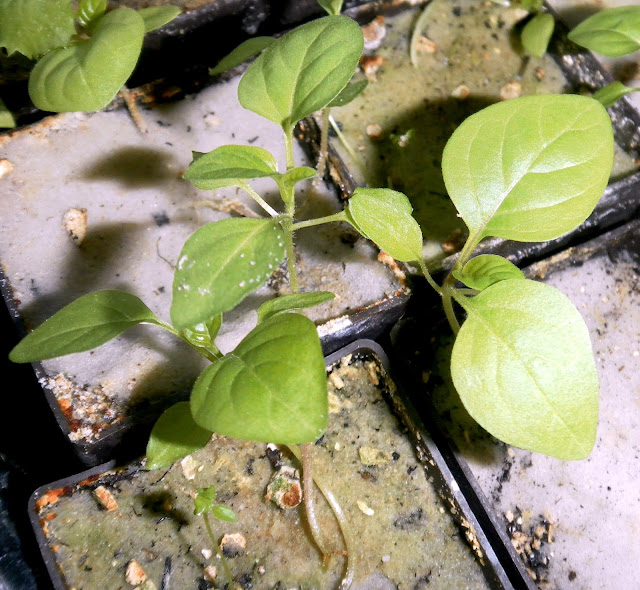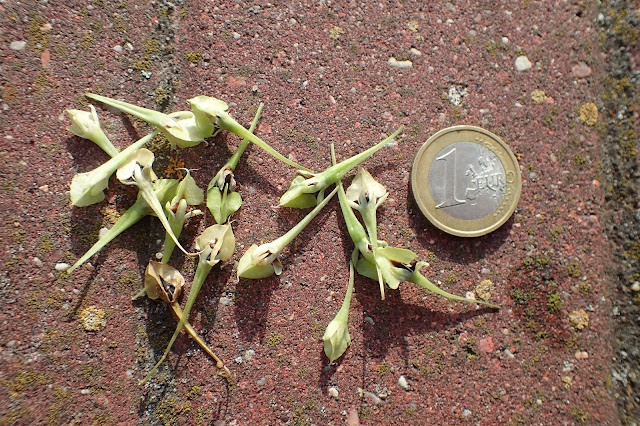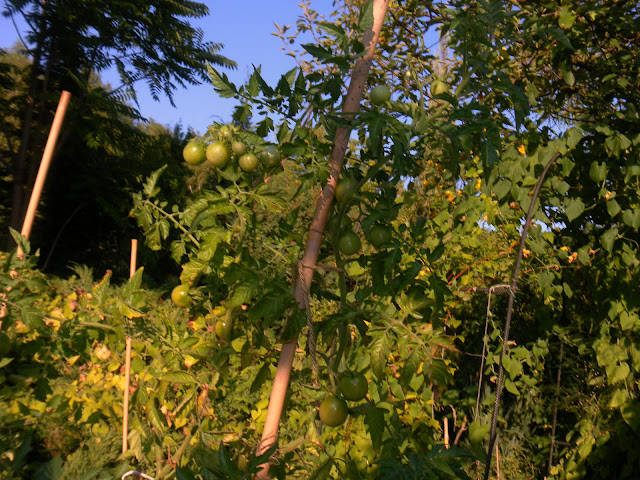There
exists about 17-18 wild tomato species. All of them were formerly
placed in genus Lycopersicon, but currently they are classified in
genus Solanum, sections: Lycopersicon, Juglandifolia and
Lycopersicoides. Each species is very special and different than
others, but all have a few similar features: yellow flowers and
pinnately compound aromatic leaves (and the same details of flower's
morphology).
Galapagos Tomato (Lycopersicon galapagense) fruits
Wild Hairy Tomato fruits (L. hirsutum f. glabratum)
To Solanum sect. Lycopersicon belong
13-14 species and all native to western South America, from
Ecuador to northern Bolivia and Chile (with two endemic species in
the Galápagos Islands). They are annual, biennial or herbaceous
perennial. Fruits are very small berries – red, orange,
whithish-green or purplish-green, sometimes striped, glabrous or
hairy. They are often edible and the taste of some species is much
other than common tomato. The taxons in this section are divided into
a few relationship groups (Neolycopersicon, Lycopersicon, Arcanum and
Eriopersicon).
To
section Juglandifolia belong two (Solanum/Lycopersicon ochranthum and
S./L. Juglandifolium) very tall, woody vining species distributed in
Colombia, Ecuador, and Peru. The fruits of them are larger and have
thick hard pericarp.
Section
Lycopersicoides (where belong also 2 species: S./L. lycopersicoides
and S./L. Sitiens) comprises shrub or subshrub species distributed in
southern Peru and northern Chile. They have pale yellow to almost
white anthers and small fruits with leathery skin.
Cultivation:
The tomatoes which belong to section Lycopersicon are mostly easy to
growing as annual, bloom and fruit in first year from seeds, although
some species are short-day flowering, so very late ripe (not always
mature in cold temperate climate – somtimes frosts are faster). The
short-day species start earlier to blooming if they are growing in
small pots than in open ground. And they need much of sunlight. Some
taxons are self-incompatible, so there is necessary to grow at least
2 plants of them (the best a few plants). Species of section
Juglandifolia are very difficult to growing in cold temperate areas.
They attain about 8-10m (27-33 ft) tall and starts to blooming only
when are very large. There is the trick – grafting theirs shoots on
other dwarf tomato species (as for example S./L. pennellii). Then the
plants flower when they are relatively small (about 2 m = 7 ft tall)
but not earlier than in the second year after grafting. And they are
very difficult to wintering, they need in winter much of sunlight and
warm temperatures. I do not know much about growing 2 species of
sect. Lycopersicoides – my only plant of S./L. lycopersicoides died
when it was young.
Propagation:
The seeds usually germinate easily and fast if sown surface. Some
species can be dormant by some time after sowing. Then GA3 can help,
or simply be patient. But in my experiences
all seeds germinated fastly.
I grew the following species:
- The
species of Lycopersicon
group (of section Lycopersicon):
Lycopersicon
humboldtii – Humboldt’s Wild Tomato – the wild small species
often treated as one of wild forms of L. esculentum. It was
discovered in 1800 by Alexander
von Humboldt and
Aimé Bonpland in Venezuela (at the "Laguna Tacarigua", the
lake of Valencia).It
cteates tall bush to about 2 m (= 7 ft), and very delicious, sweetish
(pink-)red, thin skinned fruits about 2-3(6)cm (0,8-1,2, sometimes to
2,4 inch) diameter. Plant in large degree resistant to potato blight
(Phytophtora).
The fruits are larger than cherry tomato (L. esculentum var. cerasiforme)
 The largest fruit of L. humboldtii I have harvested
The largest fruit of L. humboldtii I have harvested
Lycopersicon
pimpinellifolium – Wild Currant Tomato – the wild species native
to coastal areas from northern Peru to
central Chile (also in central coastal Ecuador). It grows in wet
places and on the edges of cultivated fields at altitude 0 to 500 m.
This species differs from common tomato in a few features: it is
almost glabrous or very short pubescent, has more flowers in
inflorescences (over 12) and has small red fruits – only about 1 cm
(= 0,4 inch) diameter. There are included 2 varieties: var.
pimpinellifolium (with the smallest fruits) and var. ribesoides
(which is probably a crossing with L. esculentum and has larger
fruits – about 1,5-1,8cm = 0,6-0,7 inch diameter). The fruits have
similar taste to common tomato but they are more delicious (the taste
is stronger). It is more resistant to diseases than cultivated
varieties. Also resistant to heat.
The fruits of L. pimpinellifolium var. pimpinellifolium:
L. pimpinellifolium var. ribesoides:
The fruits of this variety are larger than previous (the coin on the photo is size about 2,5 cm = 1 inch)
Lycopersicon
cheesmaniae (syn. L. cheesmanii) – Galapagos Wild Tomato –this is
similar to previous wild species native to Galapagos Islands. It have
yellow or orange, small -0,6-1,4 (2,5)cm = 0,3-0,6 inch (sometimes to
1 inch) diameter - fruits with taste similar to common tomato.
Species resistant to salinity. There
is very difficult to get/buy seeds of true species (in the most cases
there are sold hybrids with L. esculentum with larger fruits and
seeds). True forms have very little seeds. I grewthe true species
(but unsuccessful, I have not harvested the fruits) and 1 hybrid form
with larger, pear-shaped fruits and larger seeds (successful).
The true species:
The hybrid form with larger, pear-shaped fruits and larger seeds:



Lycopersicon
galapagense (syn. L. cheesmaniae var. minor, L. cheesmanii var.
minor) – also called Galapagos Wild Tomato – it is the second
Galapagos Islands native species. It is very different than other
species. It has 3-4-pinnate leaves (with tertiary leaflets and often
quaternary lobed) and small orange, sometimes hairy fruits (0, 5-1,1
cm = 0,2-0,5 inch) diameter with very large calyxes. The seeds are
very small. The fruits have often thick skin and are very delicious
with taste similar to common tomato. The leaves are much divided,
something similar to a fern leaves. I grew 2 forms: first with
“loose” (not dense-lobed) leaves and glabrous fruits about
0,8-1,1 cm diameter and the second with dense leaves and smaller yet,
hairy fruits. The second form was later and more difficult than first
one (in my experiences), but I can say that this species is
relatively early and easy (in comparison to some other wild species).
It is also very difficult to get/buy true species.
The "loose-leaf" form:
Small, glabrous fruits with large calyxes
The "dense-leaf" form:
Fruits of this form are very small and hairy
The leaf with tertiary leaflet (charactristic for L. galapagense)
- The
species of Eriopersicon group (of
section Lycopersicon):
Lycopersicon
hirsutum f. typicum
(syn. L.
agrimoniifolium, L. hirsutum var.
agrimoniifolium, Solanum habrochaites) -
Wild Hairy Tomato – it is sprawling
perennial shrubs or vines to 6 m (= 20 ft) long, but usually smaller.
Flowers very showy 3-5cm (=1-2 inch) diameter, golden.The fruits are
edible (in Equador they are pickled with an onion).Fruits are small
(about 1-1,5cm = 0,4-0,6 inch) diameter, green, hairy (hairs hard and
dense), very delicious when fully ripe (with specific aroma and
taste, very different than common tomato). Leaves with hairy both
surfaces. Species native to Andes from Ecuador to Peru in forests at
altitude 400-3600m (=1333-12000 ft). Plant resistant to powdery
mildews, early blight, bacterial speck, root-knot nematodes and two
species of red spider mite. Also very cold tolerant. Very late
flowering and fruiting (short-day flowering). Ripe fruits fall down
when ripe.
Flowers are quite large
It is very ornamental in blooming time
The fruits are covered by long elastic hairs
Lycopersicon
hirsutum f. glabratum
(syn. L.
hirsutum var. glabratum)
– also called Wild Hairy Tomato - - rare fruit –
it is sprawling perennial shrubs or
vines to 6 m (20= ft) long, but usually smaller. Flowers very showy
2,5-5cm (=1-2 inch) diameter, golden. The fruits are edible (in
Ecuador they are pickled with an onion as previous form). Fruits are
small (about 1-1,5cm = 0,4-0,6 inch) diameter, green, hairy (with
very fragile straight hairs), fragrant and very delicious when fully
ripe (with specific fruity aroma and taste). Leaves with glabrescent
upper surfaces. Species native to the southwestern parts of Ecuador
at lower latitudes (0-6 degrees south). This form is capable of
crossing with L. esculentum.
Plant resistant to powdery mildews, early blight, bacterial speck,
root-knot nematodes and two species of red spider mite. Also late but
earlier than f. typicum. Resistant to low
temperatures.
Fruits are covered by long stright fragile hairs
Lycopersicon
peruvianum – Peruvian Wild Tomato – it is tropical spreading (to
erect) perennial to about 0,5m (= 2 ft) tall and 2 m (= 7 ft)
diameter. It is native to central Peru to
northern Chile, on desserts or as a weed at field edges in coastal
river valleys (at altitude 0to 600 m = 0-2000 ft). The fruits are
about 1-3 cm (0,4-1,2 inch) diameter whitish-green, with acid taste
and strong smell resembling something common tomato. They usually
fall down when ripe. Flowers have characteristic curved staminal
column. This species is usually self-incompatible, but there are also
self-compatible forms. Drought resistant. I
grew 2 forms: first self-compatible and earlier and the second with
more dentate leaves, self-incompatible and very late (the fruits
ripened in December, after harvesting).
The earlier self-compatible (rare) form:
The later ripening self-incompatible form:
 |
| The fully ripe fruits of this form | | | | | |
|
|
 |
| The coin on the photo is size about 2,5 cm = 1 inch |
- The
species of Arcanum group (of
section Lycopersicon):
Lycopersicon
arcanum (syn. L. peruvianum var. humifusum) – Wild Tomato – it is
spreading, often prostrate perennial herb with woody base and shoots
to about 1-1,5m (= 3-5 ft) long. It is native to coastal and inland
Andean valleys in northern Peru, on dry valleys, and dry rocky slopes
(at altitude 100–2500 m = 333-8333 ft). The leaflets are usually
entire. Flowers have straight staminal column. Fruits are very small,
only 1-1,4 cm (0,4-0,6 inch) diameter, greenish, hard (not soft) when
ripe, with long calyxes. They fall down when ripe. The leaves and
flowers are very ornamental.
The fruits are very small
The coin on the photo is size about 2,5 cm = 1 inch
Lycopersicon
chmielewskii - Chmielewsky's Wild
Tomato - a wild species which grows in wild
state in Andean valleys in southern Peru to nothern Bolivia (at
altitude 2300-3000m = 7666-10000ft). Perennial herb (but can be grown
as annual) with woody base to 1m (=3,3 ft) tall and wide.The leaves
have characteristic cilantro-like smell. Fruits (with very large
violet tinged calyxes) very small 0,5-1,3 cm (= 0,2-0,5 inch) long,
aquamarine colored, short hairy pubescent, very delicious, acidulous,
with unusual aroma. This species has the potential for high vitamin C
content. It starts to flowering in August or September and ripens
late.
Ripe fruits
- Section
Juglandifolia:
Lycopersicon
ochranthum (syn. Solanum
ochranthum) – Giant Woody Vine
Tomato – it is
woody vine to 8-10 m (=27-33 ft) tall. The stems in base are very
thick. The flowers are large, golden-yellow and green fruits have
diameter 2-5 cm (0,8-2 inch) or even larger – they are the largest
of all wild tomato species. Also the seeds are very large. It is
native to central Colombia to southern
Peru. It grows in montane forests at altitude 1900–4100 m (=
6333-13666 ft). It can be grafted on L. pennellii or other dwarf
species to obtain smaller plants which bloom when they are about 2 m
(=7 ft) tall in the second year of growing.
The seedlings
- Section
Lycopersicoides:
Lycopersicon
lycopersicoides (syn. Solanum lycopersicoides) – Tomato
Nightshade – this is strong smelling
herbaceous or woody shrub with much divided leaves and large
inflorescences. The fruits are 1–1.2 cm in diameter,
globose, purple to black when ripe, glabrous and shiny. It is native
to Southern Peru to northern Chile on the western slopes of the Andes
(on dry rocky hillsides at altitude 1500–3700 m = 5000-12333 ft).
Very resistant to low temperatures.
The seedling
There are a few other wild tomato species yet. If you have available seeds of any of them, please write to me.









































































